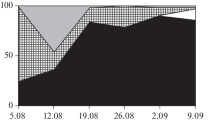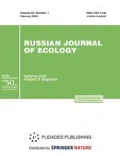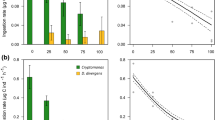Abstract
Cyanobacterial blooms are regarded as a global environmental problem. The role of cyanobacteria in the food web of water bodies is still unclear. We have carried out an experimental study of invertebrate trophic relationships during the bloom of the cyanobacterium Aphanizomenon flos-aquae. The key links of the food web—plankton, microperiphyton, detritus, and benthic invertebrates—were collected for stable isotope analysis of carbon (δ13C) and nitrogen (δ15N) after 20-day exposure in mesocosms simulating the conditions of the near-shore biotope of the Rybinsk Reservoir without cyanobacteria (variant I) and with high abundance of cyanobacteria (variant II). Statistically significant differences in the δ15N values for crustaceans (Cladocera, Copepoda, Asellus aquaticus and Gmelinoides fasciatus), and mayfly larvae have been revealed between the variants: these values were 1–4‰ lower in the variant with cyanobacteria than in the variant without them. The cyanobacteria-induced shifts in the δ15N value for consumers indicate an assimilation of diazotrophic nitrogen and incorporation of cyanobacterial nutrients into their food chains.

Similar content being viewed by others

REFERENCES
Kay, R.A. and Barton, L.L., Microalgae as food and supplement, Crit. Rev. Food Sci. Nutr., 1991, vol. 30, pp. 555–573. https://doi.org/10.1080/10408399109527556
DeMott, W.R., Zhang, Q.X., and Carmichael, W.W., Effects of toxic cyanobacteria and purified toxins on the survival and feeding of a copepod and three species of Daphnia, Limnol. Oceanogr., 1991, vol. 36, pp. 1346–1357. https://doi.org/10.4319/lo.1991.36.7.1346
Schmidt, K. and Jonasdottir, S., Nutritional quality of two cyanobacteria: How rich is ‘poor’ food?, Mar. Ecol. Progr. Ser., 1997, vol. 151, pp. 1–10. https://doi.org/10.3354/meps151001
Mohamed, Z.A., Bakr, A.A., and Ghramh, H.A., Grazing of the copepod Cyclops vicinus on toxic Microcystis aeruginosa: Potential for controlling cyanobacterial blooms and transfer of toxins, Oceanol. Hydrobiol. Stud., 2018, vol. 47, no. 3, pp. 296–302. https://doi.org/10.1515/ohs-2018-0028
Sitnikova, T., Kiyashko, S.I., Maximova, N., et al., Resource partitioning in endemic species of Baikal gastropods indicated by gut contents, stable isotopes and radular morphology, Hydrobiologia, 2012, vol. 682, pp. 75–90. https://doi.org/10.1007/s10750-011-0685-5
Korneva, L.G., Lazareva, V.I., Mineeva, N.M., et al., The state and dynamics of biological communities in the Rybinsk Reservoir under climate changes, J. Sib. Fed. Univ., Ser. Biol., 2019, vol. 12, no. 2, pp. 160–179. https://doi.org/10.17516/1997-1389-0037
Mayer, B. and Wassenaar, L.I., Isotopic characterization of nitrate sources and transformations in Lake Winnipeg and its contributing rivers, Manitoba, Canada, J. Great Lakes Res., 2012, vol. 38, pp. 135–146. https://doi.org/10.1016/j.jglr.2012.02.004
Karlson, A.M.L., Duberg, J., Motwani, N.H., et al., Nitrogen fixation by cyanobacteria stimulates production in Baltic food webs, AMBIO, 2015, vol. 44, Suppl. 3, pp. 413–426. https://doi.org/10.1007/s13280-015-0660-x
Kiyashko, S.I., Richard, P., Chandler, T., et al., Stable carbon isotope ratios differentiate autotrophs supporting animal diversity in Lake Baikal, C. R. Acad. Sci. Paris: Sci. de la Vie, 1998, vol. 321, pp. 509–516.
Finlay, J.C. and Kendall, C., Stable isotope tracing of temporal and spatial variability in organic matter sources to freshwater ecosystems, in Stable Isotopes in Ecology and Environmental Science, Michener, R. and Lajtha, K., Eds., Oxford: Blackwell, 2007, pp. 283–333.
Post, D.M., Using stable isotopes to estimate trophic position: Models, methods and assumptions, Ecology, 2002, vol. 83, pp. 703–718. https://doi.org/10.1890/0012-9658(2002)083[0703:USITET]2.0.CO;2
Dionne, K., Dufresne, F., and Nozais, C., Variation in δ13C and δ15N trophic enrichment factors among Hyalella azteca amphipods from different lakes, Hydrobiologia, 2016, vol. 781, pp. 217–230. https://doi.org/10.1007/s10750-016-2846-z
Gorbatenko, K.M., Kiyashko, S.I., Lazhentsev, A.E., et al., Trophic relationships and bentho–pelagic connections in the Western Kamchatka shelf according to analysis of gut contents and stable 13C and 15N isotope ratio, Izv. TINRO, 2013, vol. 175, pp. 3–25.
Berezina, N., Razinkovas-Baziukas, A., and Tiunov, A., Non-indigenous amphipods and mysids in coastal food webs of eastern Baltic Sea estuaries, J. Mar. Biol. Assoc. UK, 2017, vol. 97, no. 3, pp. 581–590. https://doi.org/10.1017/S0025315416000643
Makhutova, O.N., Protasov, A.A., Gladyshev, M.I., et al., Feeding spectra of bivalve mollusks Unio and Dreissena from Kanevskoe Reservoir, Ukraine: Are they food competitors or not?, Zool. Stud, 2013, vol. 52, p. 56. https://doi.org/10.1186/1810-522X-52-56
Lesutienė, J., Bukaveckas, P.A., Gasiūnaitė, Z.R., et al., Tracing the isotopic signal of a cyanobacteria bloom through the food web of a Baltic Sea coastal lagoon, Estuar. Coast. Shelf Sci., 2014, vol. 138, pp. 47–56. https://doi.org/10.1016/j.ecss.2013.12.017
Van der Zanden, M.J., Clayton, M.K., Moody, E.K., et al., Stable isotope turnover and half-life in animal tissues: A literature synthesis, PLoS ONE, 2015, vol. 10, no. 1, e0116182. https://doi.org/10.1371/journal.pone.0116182
Oberhaus, L., Gelinas, M., Pinel-Alloul, B., et al., Grazing of two toxic Planktothrix species by Daphnia pulicaria: Potential for bloom control and transfer of microcystins, J. Plankton Res., 2007, vol. 29, pp. 827–838. https://doi.org/10.1093/plankt/fbm062
Briland, R.D., Stone, J.P., Manubolu, M., et al., Cyanobacterial blooms modify food web structure and interactions in western Lake Erie, Harmful Algae, 2020, vol. 92, 101586.https://doi.org/10.1016/j.hal.2019.03.004
Motwani, N.H., Duberg, J., Sveden, J.B., et al., Grazing on cyanobacteria and transfer of diazotrophic nitrogen to zooplankton in the Baltic Sea, Limnol. Oceanogr., 2018, vol. 63, pp. 672–686. https://doi.org/10.1002/lno.10659
Kopylov, A.I., Lazareva, V.I., Pyrina, I.L., et al., Microbial loop in the planktonic trophic web of a large plain reservoir, Usp. Sovrem. Biol., 2010, vol. 130, no. 6, pp. 544–556.
Boulion, V.V., The structure and function of the “microbial loop” in the plankton of lake ecosystems, Biol. Vnutr. Vod, 2002, no. 2, pp. 5–14.
Verbitsky, V.B., Kurbatova, S.A., Berezina, N.A., et al., Responses of aquatic organisms to cyanobacteria and Elodea in microcosms, Dokl. Biol. Sci., 2019, vol. 488, no. 1, pp. 136–140.
ACKNOWLEDGMENTS
The authors are grateful to I.Yu. Ershov for his assistance in the experiment and to V.B. Verbitskii and A.N. Sharov (Papanin Institute for Biology of Inland Waters, Russian Academy of Sciences) for their valuable advice and discussion of the manuscript.
Funding
This study was performed under state contracts from the RF Ministry of Science and Higher Education nos. AAAA-A19-11902066900091-0 (N.A. Berezina), AAAA-A18-118042490059-5 (A.V. Tiunov and S.M. Tsurikov), AAAA-A18-118012690101-2 (S.A. Kurbatova and S.N.Bykova), and AAAA-A18-118012690096-1 (L.G. Korneva and O.S. Makarova).
Author information
Authors and Affiliations
Corresponding author
Ethics declarations
The authors declare that they have no conflict of interest.
Additional information
Translated by D. Zabolotny
Rights and permissions
About this article
Cite this article
Berezina, N.A., Tiunov, A.V., Tsurikov, S.M. et al. Cyanobacteria as a Food Source for Invertebrates: Results of a Model Experiment. Russ J Ecol 52, 247–252 (2021). https://doi.org/10.1134/S1067413621030036
Received:
Revised:
Accepted:
Published:
Issue Date:
DOI: https://doi.org/10.1134/S1067413621030036



